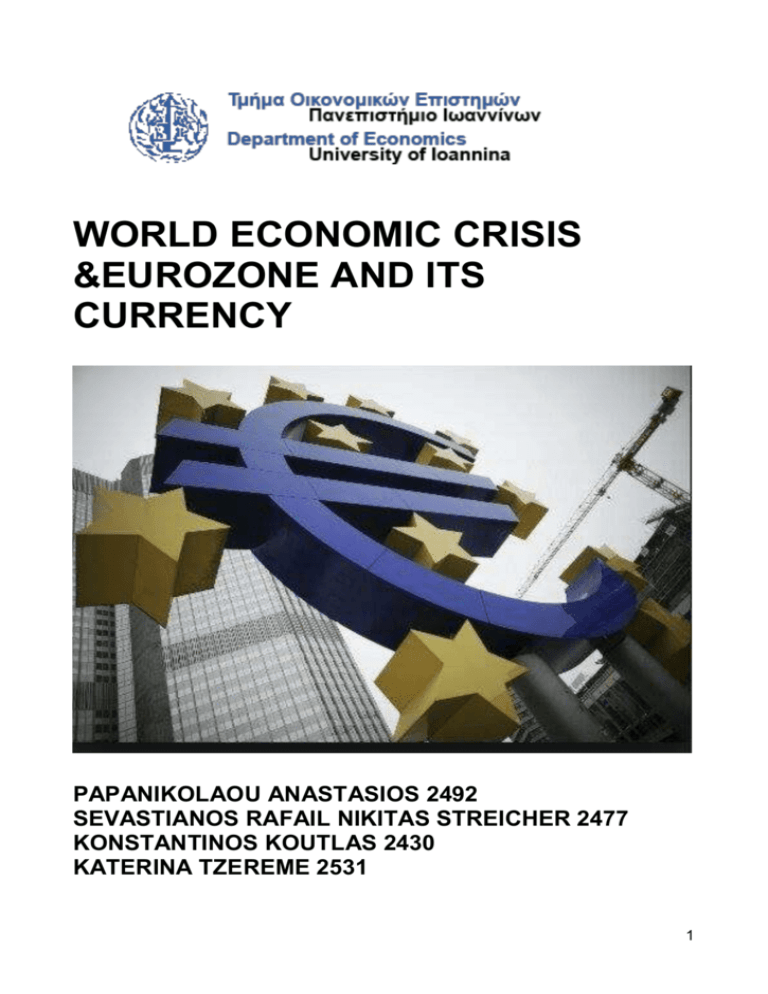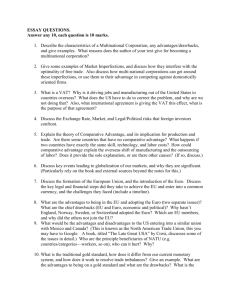3. euro as common currency
advertisement

WORLD ECONOMIC CRISIS &EUROZONE AND ITS CURRENCY PAPANIKOLAOU ANASTASIOS 2492 SEVASTIANOS RAFAIL NIKITAS STREICHER 2477 KONSTANTINOS KOUTLAS 2430 KATERINA TZEREME 2531 1 1.INTRODUCTION In any system a crisis is a length of time in which the system doesn’t function properly, signaling the need for immediate help.So in an economy, a crisis can be seen as that length of time where economy functions poorly.In this length of time the value of organizations , particularly fiscal institutions ,falls really fast and all things are seen of no value.Production is low and sometimes doesn't meet the amount of demand.The world financial crisis that started in 2008 is a very typical example of a fault that lead the economy not to work properly. 2.WORLD CRISIS The world financial crisis started in 2008 came as a result of the real estate bubble in the US which had as a result the collapse or the risk of collapsing for some financial institutions such as the Lehman Brothers collapse and the rescue of the Bear Stearns investment bank .Most of these financial institutions had invested in high risk bonds whose value went down when the housing bubble shrunk between 2007 and 2008.These housing bubbles came from two main factors:1.low interest rates in the US and 2) Noteworthy increase in savings from rising economies.These elements as a result had a large increase in demand for investments with high returns.Large investment banks linked the housing markets to this large mass of savings with groundbreaking new securities,feeding housing bubbles in the US and europe.And the effects when the housing bubble popped are well known,Economies all over the world 2.1 THE EFFECTS OF THE GLOBAL CRISIS IN THE EUROPEAN UNION The European union is an economic and political union of twenty eight countries created on the first of November 1993 by the Maastricht Treaty. The purpose of creating the European union was to assist the citizens of Europe with the social, economic and individual flourishing . As mentioned previously the global crisis began in the United States of America 2008 .The crisis spread quickly to the countries of Europe so the European union had to find an immediate solution. The problems that were created by the crisis were many. First of all the fiscal deficits and debt continued to increase rapidly , unemployment would increase so production would decline and there would be discontent among the citizens. There would be additional imbalances in the current account so the European union would have to find a direct solution to avoid a long period of recession. Finally the biggest problems arisen from the fact that some countries had great economic growth and one by one shall represent the interests of their own country something impending the prompt resolution of problems. 2.2 WHAT LED TO THE EUROPEAN CRISIS ? First of all opening the borders to third countries, free movement of goods, services, capital and non-audit of the financial markets developed the main causes of the crisis. Alongside the flourishing of free competition and different expectations and requirements of the countries that are a part of the EU, overshadowed the reason for creating the European Union. So we see that the policies of deregulation and liberalization of financial markets and the prevalence of free competition led to the crisis which seems to be a result of globalization and other structural weaknesses that the system of the European Union showed. In the same time borrowing money from the European central bank but also from other countries to cover previous loans rise the debt because of the very high rates , spending large sums of money to buy military equipment and various legal barriers that lead to lower investment and increase unemployment. As we see there are many political issues to be resolved but also to find a common ground between the Member States of the European Union 3. EURO AS COMMON CURRENCY 2 The creation of a common currency had been the main target of the Economic and the Monetary union for many decades and a great ambition for the Europeans. In fact ,it was widely believed as the most necessary step for a political integration and the creation of a union European market. So, in 1999 euro was invented and made a huge progress in the union of Europe by becoming currency of 11 European countries. Nowadays 17 of the 28 countries-members of the Eurozone and more than 330.000.000 Europeans are using it. It is well known that in order to become a member of the union and adjust euro as currency countries need to fulfill specific standards . 3.1 POSITIVE AND NEGATIVE ASPECTS Initially we start with the positive side of having a common currency . First of all the absence of exchange rates between countries which have euro as their currency facilitates the exchanges of products , capital and labor force so it leads to an increase of investment and also the gross domestic product of each member of the EU. Similarly, consumers are able to compare the real value of products which leads to the increase of competitiveness and tends to improve the quality of European products. Finally apart from the economic advantages the common currency has also political benefits as it aims to spread the feeling of a united Europe. On the other hand we have the negative effects since every economy is not the same . To begin with the disadvantages when you don’t have your own currency you lose the option of a devaluation to overcome some difficulties such as a recession. Although the existence of different economies shows us that every country will have different problems , so the European union institutions like the European central bank will have to solve different problems in the same time with the same policy in different countries something that is impossible to happen. Finally we see that having a common currency is more likely to spread crisis and bank panic to all the members of the Eurozone as we have seen the past years . 4. Future prospects There is uncertainty for the future but there will be changes in productivity ensuring financial development .The money-based outlook is very uncertain and there will be a fairly slow and bumpy recovery in the US and Europe . Five years after the worldwide major money-based problem, the world economy is showing signs of bouncing back this year, pulled along by a recovery in high-income economies, says the World Bank's latest president. A significant growth is also expected from the developing-countries . Moreover , global economy is considered great in all areas and it is growing in unity and rapidly . Miraculously , Europe is growing and capital is beginning to return, which has made policymakers "floatable" says CFR's Robert Kahn, but officials face the challenge of increasing the growth rate . In addition , structural rebalancing in Europe will take time and possible growth will be low in 2014 and beyond. Recovery in the advanced countries will eventually restore some growth potentially coming from the trades area, but probably not in 2014 with the huge European market treading water. Despite the fact that euro area growth is on track to reach one percent next year , there is a risk that the crisis could return making an uncertain worldwide maturation outlook that will hold down exports , macroeconomic policies and a framework for monetary union . Furthermore , even this level of growth is not enough to reduce the high levels of unemployment and more importantly the youth unemployment, which averages nearly 24 percent for the euro zone and goes beyond 35 percent in several countries, represents a critical threat to Europe's future . It is also said that Banking union will be the focus of policy efforts to advance money-based union in 2014 , because parliamentary elections in May could set back efforts to negotiate a transatlantic trade agreement . Finally , it is concerned with the in-depth analysis of its main causes, policy proposals for a recovery from the serious problem and reform strategies for the reconstruction of a more durable and equal euro zone in the future. 3 5. Conclusion To sum up , all these positive and negative situations have had a major impact on real world problems .Capital for the Future is identifying newly appearing trends of investment and saving . Of course , every person in this world should overcome negative pressure because the only missing ingredient to a stronger economy is confidence . In addition , optimism has helped businesses to reduce their costs and families have reduced the money they owe ,but growth will not follow easily . The European Central Bank (ECB) also will need to do more to cause new lending, especially for small and medium projects in the edge . It is referred that European leaders need to win back their citizens and make a better case for a faster move to money-based and political union . The challenge, therefore, is to restore growth before markets lose confidence in the reform process again. Not doing so could make 2014 the year the serious problem returns. Euro, probably more than any other currency, represents the back and forth between people confidence at the heart of our community. It is the first currency that has not only cut off its link to gold, but also its link to the nation state(Wim Duisenberg , President of the ECB in 2001, quoted in Marsh, 2009, p. 1) . Europe's combination could not succeed if it promised to make the strong areas stronger and the weak ones weaker(Magnifico , 1973, p. 8) . Yet Europe is in deep serious problem because its proudest achievement , the single currency adopted by most European nations, is now in danger now struggling to avoid bankruptcy . Lastly , in order to create a healthy community and society within the European Union , euro zone should aim to reach international level in all policies , managing flexibility for get along with newcomer states and enlargement that was meant to increase the opportunities for the people of the Union . References. 1)WORLD BANK (2014) http://www.worldbank.org/en/publication/global-economicprospects [ 16-5-2014 ] 2)cfr (2013) http://www.cfr.org/international-finance/prospects-global-economy2014/p32068?cid=rss-fullfeed-prospects_for_the_global_econo-121313 [ 16 – 5 – 2014 ] 3)PwC (2011) http://www.pwc.co.uk/economic-services/issues/future-prospects-for-worldeconomies.jhtml [ 16- 5 – 2014 ] oxford journals (2013) http://cje.oxfordjournals.org/content/37/3/463.extract [ 16 – 5 – 2014 ] 4)new york times (2011) http://devo.lbl.gov/~dhaxton/Site_6/Articles_files/The%20Road%20to%20Economic%20Crisi s%20Is%20Paved%20With%20Euros%20-%20NYTimes.com.pdf [ 16 – 5 – 2014 ] 5)caspian weekly (2011) http://en.caspianweekly.org/main-subjects/others/europeanunion/3630-what-are-the-future-prospects-of-the-european-union.html [ 16 – 5 – 2014 ] 6)what is economics(2014) http://www.whatiseconomics.org/the-global-financialcrisis/what-is-an-economic-crisis[16-5-14] 7)wikipedia (2012)http://en.wikipedia.org/wiki/Causes_of_the_Great_Recession [16-5-14] 8)the economist(2013)http://www.economist.com/news/schoolsbrief/21584534-effects-financialcrisis-are-still-being-felt-five-years-article[16-5-14] 9) wikipedia(2014) http://el.m.wikipedia.org/wiki/Ευρώ [16-5-14] 10)european committee (2014) http://ec.europa.eu/economy_finance/euro/index_el.htm [16-5-14] 4 11)wikibooks (2014) http://el.m.wikibooks.org/wiki/Η_μετάβαση_στο_ευρώ_και_η_επίδραση_στην_ελληνική_οικονομία_ και_κοινωνία [16-5-14] 12) economica http://www.economica.gr/files/kafidas_euro.pdf 13) wikibooks(2014) http://el.wikibooks.org/wiki/Οικονομική_κρίση._Αιτίες_και_αποτελέσματα [15-5-14] 14) europedia (2014)http://europedia.moussis.eu/discus/discus-1330588836-40293419693.tkl?lang=gr [15-5-14] 5 6







